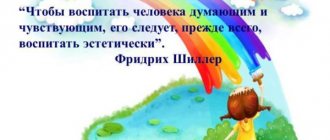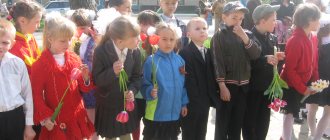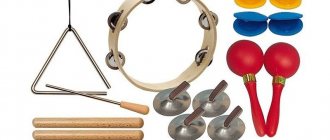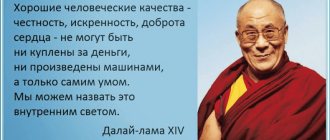The concept and essence of aesthetic education of preschool children
Definition 1
Aesthetic education is a purposeful process of influencing the personality of a preschool child, with the goal of developing his ability to see beauty in the world around him, works of art, as well as the ability to create beauty on his own.
Note 1
Aesthetic education of children must begin from the very first days of life.
Aesthetic education is a purposeful process of developing creative activity in preschool children, the ability to perceive and appreciate beauty in nature, life and art. Aesthetic education of preschool children includes instilling in children an aesthetic attitude towards social life, work, nature, art and everyday life. However, knowledge of works of art is very multifaceted, so it stands out as a separate part of the aesthetic education of children.
Are you an expert in this subject area? We invite you to become the author of the Directory Working Conditions
In the process of aesthetic education, preschool children become acquainted with the beauty in the surrounding life, nature and art, they learn to perceive and feel this beauty. This process contributes to the development of their imagination and imagination.
The system of aesthetic education for preschool children includes:
- education through artistic means;
- education through art;
- education through extra-artistic means (nature, work, environment, educational activities, etc.).
Note 2
Thus, the process of aesthetic education includes general cultural, philosophical and psychological-pedagogical education.
The purpose and objectives of aesthetic education of preschool children
The main goal of aesthetic education of preschool children is to give children the necessary knowledge, skills and abilities from various fields of art, as well as to develop their interest and desire to engage in independent creative activities.
Finished works on a similar topic
Course work Aesthetic education of preschool children 480 ₽ Abstract Aesthetic education of preschool children 220 ₽ Test work Aesthetic education of preschool children 200 ₽
Receive completed work or specialist advice on your educational project Find out the cost
Achieving the main goal of aesthetic education of preschool children is achieved through the consistent solution of a number of the following groups of tasks:
- The first group of tasks of aesthetic education are tasks aimed at developing in children an aesthetic attitude towards the world around them and their acquisition of theoretical knowledge. Includes a number of the following tasks:
- education of aesthetic culture in children;
the formation and development of aesthetic perceptions, feelings and experiences, as well as an aesthetic attitude towards the activities surrounding the child;
- developing in children the ability to see and feel beauty in actions, nature, art, and the world around them;
- cultivate the need for knowledge of beauty;
- nurturing the desire to surround yourself with beauty, to create it with your own hands.
- The second group of tasks of aesthetic education of preschool children is the formation in children of practical skills in the field of various types of arts. Includes:
- teaching children to sculpt, draw, design, sing, and move to music;
formation and development of oral creativity.
Aesthetic education of preschool children within the preschool educational institution involves solving the following problems:
- Carrying out the systematic development of the perception of beauty and aesthetic feelings of children, through various types of arts, activities, emotional involvement, etc.
- Introducing children to art, teaching them practical skills, educating them to bring elements of beauty into the environment as much as possible.
- Formation in children of aesthetic taste and the ability to independently evaluate works of art and life phenomena.
- Development of children's creative and artistic abilities through the organization of activities related to art.
Aesthetic education is the most important aspect of raising a child
Tatyana Batyukova
Aesthetic education is the most important aspect of raising a child
Aesthetic education is a purposeful, systematic process of influencing a child’s personality in order to develop his ability to see the beauty of the surrounding world, art and create it. It starts from the first years of children's lives.
Aesthetic education is the most important aspect of raising a child. It contributes to the enrichment of sensory experience, the emotional sphere of the individual, affects the knowledge of the moral side of reality (it is known that for a preschooler the concepts of “beautiful” and “kind” are almost identical, it also increases cognitive activity, and even affects physical development. The result of aesthetic education is aesthetic development .
The content of aesthetic education for preschool children includes the study of elements of the theory of aesthetics; systematic communication with artistic culture; organized participation in artistic creativity.
The process of aesthetic education is carried out using certain means: aesthetics of everyday life, nature, various types of arts; (arts and crafts, music, painting, literature, architecture, theater).
The teacher must lead the child from the perception of beauty and emotional response to it to understanding and the formation of aesthetic ideas, judgments, and evaluations.
The tasks of aesthetic education of preschoolers, based on its goal, can be presented in two groups.
The first group of tasks is aimed at developing children’s aesthetic attitude towards their surroundings. The following is provided: to develop the ability to see and feel beauty in nature, actions, art, to understand beauty; cultivate artistic taste, the need for knowledge of beauty.
The second group of tasks is aimed at developing artistic skills in the field of various arts: teaching children to draw, sculpt, design; singing, moving to music; development of verbal creativity.
The leading methods for solving problems of the first group are demonstration, observation, analysis, and the example of an adult. Showing as a method of education is used during initial acquaintance with the subject of aesthetic reality. It is important for the teacher to determine the object of the display and create conditions so that the children’s attention is focused on what they are shown and asked to listen to.
To solve problems of the second group, practical methods are required as leading ones: demonstration, exercise, explanation, method of search situations. These methods are discussed in detail in the methods of visual activity and music education.
Direct teaching methods are needed: demonstration, exercise, examination of objects, description. In these cases, learning becomes one of the factors that stimulate creativity, and creative tasks give learning a developmental character.
Preschoolers have access to almost all types of artistic activities - writing stories, inventing poems, singing, drawing, modeling. Already at this stage, the development of children’s artistic creative abilities occurs, which are manifested in the emergence of an idea, in its implementation in reality, in the ability to combine their knowledge and impressions, in greater sincerity when expressing feelings and thoughts.
The uniqueness of children's creativity also lies in the fact that it is based on such a pronounced feature of preschool children as imitation, which is widely reflected in the play activities of children - the figurative realization of their impressions of the world around them.
It is in play that the creativity of preschoolers first manifests itself. A game that arises on the initiative of children is characterized by the presence of a plan. At first it is not yet stable, one plot gives way to another; The older the children, the more complete and focused the plan becomes.
Just as in play, children's creativity manifests itself in other types of their artistic activities. In drawing, modeling, stories, songs, the child satisfies his need for an effective, figurative expression of his impressions. And here, first, a plan is born, and then a means of putting it into practice; children combine their impressions obtained from the perception of various works of art. And in this case, the child remains as sincere as in the game: he does not just copy what he saw, but conveys his attitude towards it.
In the development of children’s artistic and creative abilities, a special role belongs to the personality of the teacher, his culture, knowledge, and passion.
By instilling in children the basics of aesthetic taste, we teach them to see and feel the beauty of the world around them, and to cherish it. It is better to keep a flower in a flowerbed, but in order for it to bloom and bring joy to others, it must be looked after. Cleanliness in the group, which creates comfort and beauty, must be maintained, not littering, and putting away toys and books. Thus, in the process of education and training, the tasks of aesthetic education in preschool age are carried out.
To implement the tasks of aesthetic education of children, certain conditions are necessary. First of all, this is the environment in which the child lives and develops. It has an impact on the child that can hardly be compared with others in its strength and significance. If the environment is aesthetic, beautiful (not necessarily rich, if the child sees beautiful relationships between people, hears beautiful speech, etc., then from an early age he will accept the aesthetic environment as the norm, and everything that differs from the norm will cause his rejection.The aesthetics of everyday life in a kindergarten is manifested in artistic simplicity, in a thoughtful selection of household items, where each thing has its place.
The concept of “everyday aesthetics” also includes the beauty of everyday relationships between people who surround the child. It is very important what kind of speech he hears, what intonations. It is necessary that it be correct, figurative, rich in intonation and friendly.
The aesthetics of everyday life is also a person’s appearance. Carelessness, untidiness in clothing, awkwardness in the selection of colors, inability to find your own style - all this is contrary to the law of beauty.
is a powerful means of aesthetic education .
The teacher reveals to children the world of nature, helps them see its beauty in a drop of dew on a bud, and in the interweaving of grasses, and in the colors of the sunset... You just need to see this beauty for yourself and find words that are accessible to the child’s heart. Works of art about nature will provide him with invaluable help in this, which he must know well and skillfully use. In education using the means of nature, it is necessary not only a passive contemplative, but also an effective principle (to protect nature, to help it).
Therefore, the teacher thoroughly prepares for excursions, during which children receive and accumulate the sensory experience they need. Excursions, when properly prepared and conducted, broaden the horizons of preschoolers, teach them to see, compare, generalize, which forms the basis for the development of creative imagination and abilities.
A multifaceted and inexhaustible means of aesthetic education is art: fine art, music, literature, architecture, theater, cinema. The early introduction of children to real high art contributes to the emergence in the child’s soul of a truly aesthetic perception of reality. Each type of art reflects life in its own way and has its own special impact on the child’s mind and feelings.
From the first years of life, children are accompanied by oral folk art and children's literature. A fairy tale occupies a special place in their lives.
Forms of organization of aesthetic education
The teacher manages the development process of children. Children themselves love art.
activity, and often engage in it on their own initiative. It cannot be said that independent artistic activity is completely carried out without the guidance of an adult. It's just that the nature of this guide is indirect. The teacher takes care of the child’s accumulation of experience and impressions, which will later be reflected in independent drawing, modeling, stories, and musical activities; teaches visual arts and techniques.
Independent artistic activity arises on the initiative of children to satisfy their individual needs: make a gift for mom, make a toy for playing, etc. The teacher’s task is, without violating the child’s plan, to help him if such a need arises. The teacher develops children's independence using hints, drawing attention to a subject, object, questions, suggestions, assessing the results and level of independence, fiction, fantasy.
Independent activity can be individual in nature, and sometimes children unite in groups of two or three and, having discussed their idea, together prepare a concert, draw scenery, make attributes for the game, organize a theatrical game, etc.
Independent artistic activity is closely related to the work that the teacher carries out purposefully and in various forms. These could be organized classes on speech development, visual arts, or music. They are included in the mandatory “grid” of weekly classes, conducted systematically according to pre-developed content and in order of increasing complexity.
The teacher organizes excursions into nature, to monuments, to a museum, to a festively decorated street, etc. The teacher’s task is to think through the content of the excursion, taking into account the laws of children’s perception and educational tasks. It is necessary to determine and study in advance the location of the excursion, the method of placing children around the object of observation, since it is very important not only to impart new knowledge to preschoolers, but also to evoke aesthetic feelings in them.
One of the forms of children's activities that contribute to aesthetic education is theatrical games and dramatization games. These games are held under the guidance of a teacher.
Holidays and entertainment occupy a significant place in the pedagogical process of a preschool institution and in the lives of children.
Entertainment as a form of work with preschool children is held once every two weeks. The entertainment content is varied. These can be themed literary and musical evenings.
Such evenings of entertainment bring joy to preschoolers, introduce them to national culture, and cultivate aesthetic feelings.
When holding holidays, a complex of educational tasks is solved - moral, intellectual, as well as physical education tasks. And of course, they implement the tasks of aesthetic education.
The holiday should be emotionally rich. The beauty of the setting, the solemnity of the music, the general high spirits - all this increases sensitivity to the aesthetic side of reality. Children want to actively participate in the holiday; they are not satisfied with the role of observers. One will read poetry, another will sing, the third will dance. No child should be deprived of the opportunity to show what he is capable of and feel equal in an atmosphere of shared joy.









